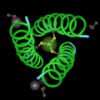tags: moose, bioinformatics class, willows, plant genes
PZ's morning post about a bear killing a moose in someone's yard (they do live in Alaska, after all), reminded me that it's time to make an announcement about our upcoming course.
No, no, no! We're not going to kill any moose on the premises. We're going to learn about the moose and its food, not the moose as its food.
But, if you take the course that precedes ours, you might get to see some moose, and you might get to see some bears eating salmon. 
The class before ours is entitled "Ecology of South Central Alaska " and they have field trips! Participants visit Turnagain Pass and the Kenai Peninsula south of Anchorage to study boreal forest succession, fire ecology, moose, bears, and salmon, and on the return trip, visit a coastal rainforest site. They also visit Hatcher Pass, where the alpine tundra rises above the boreal forest and the Palmer Hayflat wetlands.
If you're a college instructor or a high school teacher, these courses are a great bargain. Registration only costs about $50 a course (you do pay for travel, food, and lodging). The other courses offered this year include classes on forensic science, computer programming, ecology, teaching (filed under "pedagogy"), astronomy, active learning, and many more topics. Plus, some of the courses are taught in really interesting places. Our course will be in Alaska, but there are also courses in Belize, the Galápagos Islands, China, Iceland, Italy, Mexico, the Andes Mountains, and Yosemite National Park.
The last time I wrote about our Chautauqua course, the funding situation was, shall we say, a little uncertain, and none of us really knew if there'd be a course or not.
Happily, the NSF came through. The 2007 Chautauqua program has received funding and registration for summer classes is happening even as I write!
Bioinformatics, moose, and willows
You're probably wondering, about now, just how is a bioinformatics course connected to a course on moose and salmon and Alaskan plants?
Here's our tentative plan:
The ecology course spends a bit of time on moose and their food, willows. Willows, like many plants, try to protect themselves by making toxic compounds. In order to live, moose must detoxify the poisonous compounds made by the willows.
We will use bioinformatics resources to investigate this relationship. That is, can we identify genes in the willow that might be turned on after the moose have been chewing them? Can we identify genes in the moose that might detoxify willow compounds? Can we design primers to assay for expression of those genes? What can we say about the evolutionary relationships between plant toxins, and the evolutionary relationships between different herbivores?
And of course, we'll do some of the things that we normally do in these workshops, like have everyone get data sets, make phylogenetic trees, and use structure-viewing programs to have fun with proteins and DNA. It will be lots of fun.

I thought this might be of interest for Genomeweb.
Great job on the people that got this going. I totally wish I was attending! Loving the idea of real environments for phylogeny, rather than a lab.
Chris
Uh, the phylogeny part will, unfortunately, be located indoors in the computer habitat. I'm not sure there's a great wireless connection out there in the woods.